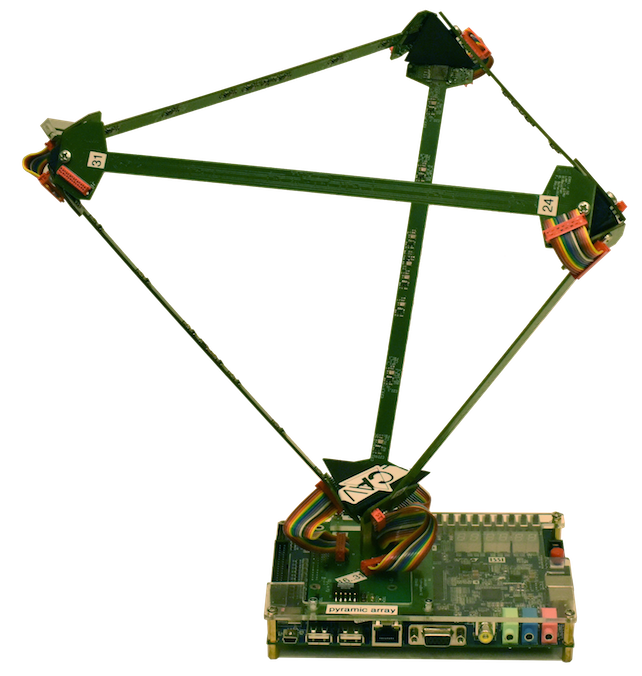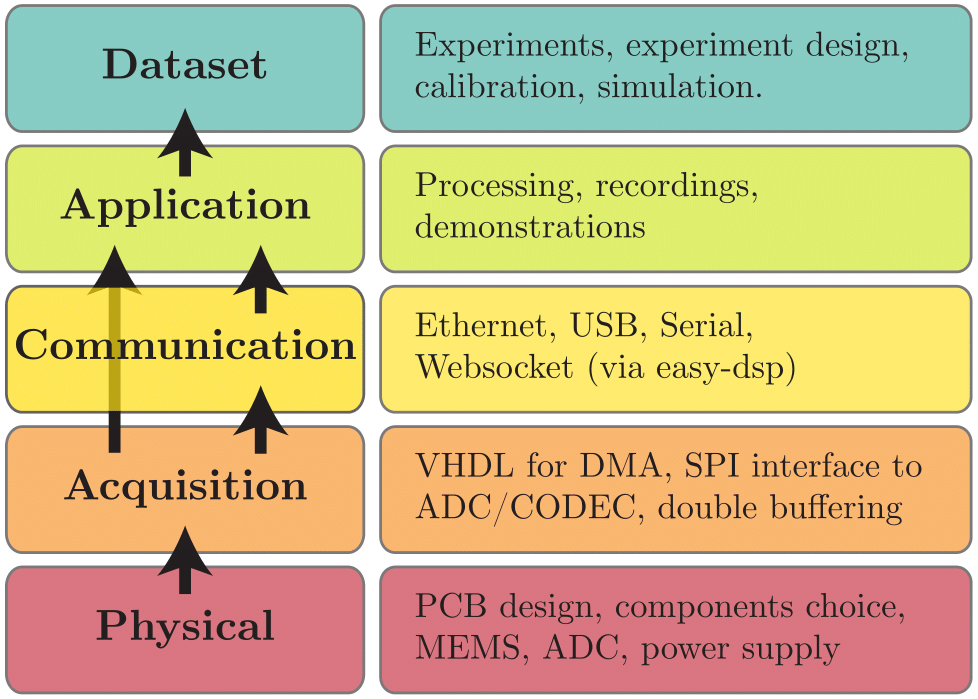This repository contains the design files and the documentation for the Pyramic compact microphone array. Pyramic has 48 microphones spread on 6 PCBs, each bearing 8 MEMS microphones and an ADC. This allows for flexible geometries while keeping calibration simple. The array plugs in a DE1-SoC FPGA that collects the data from the 6 ADC and can do real-time processing of the signals with output to an audio codec. Alternatively, the data can be sent to an ARM CPU that is on the same chip for further processing.
Juan Azcarreta Ortiz, René Beuchat [2], Robin Scheibler [1], Francisco Rojo, Corentin Ferry [2]
[1] Audiovisual Communications Laboratory (LCAV) at EPFL.
[2] Processor Architecture Laboratory (LAP) at EPFL.
Robin Scheibler
Tokyo Metropolitan University, TMU
Ono Lab
Department of Computer Science
Graduate School of System Design
6-6 Asahigaoka, Hino-shi
Tokyo, Japan
- The PCBs were designed in Altium.
- The FPGA cores were developed using Altera's tools (the free web edition should be sufficient). The installation steps are explained in the
fpga/README.mdfile.
The Pyramic array is designed as a full-stack modular system. This means that different parts of the system can be accessed independently depending on the research interests of the user. The following figure summarizes the main layers of the full-stack Pyramic array model:
Next, we explain where to find the different modules:
- Physical layer: The PCB design can be found under the
pcbfolder in this github repository. - Acquisition layer: The FPGA design can be found in the
fpga/MIC_ARRAY/hwfolder. - Communication layer: The communication accross peripherals in the DE1-SoC board is controlled by a Hardcore Processor System (HPS) and the design files can be found in the
fpga/MIC_ARRAY/sw/hpsfolder. TheUltimate_Guide.pdfexplains how to connect the Pyramic array to a host computer through an Ethernet connection. - Application layer: The application files for the demo presented at IWAENC2018 are available here. To compile an application project follow the steps in the following section (i.e.
From Zero to Pyramic Compilation). - Dataset: Anechoic dataset available in zenodo.
(on Ubuntu linux)
The FPGA part
-
Follow
fpga/README.mdto install the Altera SoC EDS and Quartus Lite -
Open Quartus
nios_command_shell quartus & -
Open Pyramic project:
File -> Open Project...and selecthw/quartus/Pyramic_Array.qpf -
Open Qsys via Quartus by
Tools -> Qsys -
In Qsys, generate the HDL files
Generate -> Generate HDL...and clickGenerate -
Back in Quartus, compile by
Processing -> Start Compilation -
Generate the hardware header
cd fpga/MIC_ARRAY ./create_hw_headers.sh -
Generate
RBFfilequartus_cpf -c hw/quartus/output_files/Pyramic_Array.sof socfpga.rbf
and place it at the root of the SD card
Hopefully, things went smoothly. Now we can try to compile the library that lets us control Pyramic from HPS.
-
For the compilation, some additional C libraries are required
sudo apt-get install libc6-dev-i386 sudo apt-get install zlib1g:i386 -
Start the embedded development shell
embedded_command_shell -
Compile
libpyramiciocd fpga/MIC_ARRAY/sw/hps/application/pyramicio make all -
The files
pyramicio.handlibpyramicio.socan be copied to the system on the DE1-SoC
-
J. Azcarreta, R. Scheibler and R. Beuchat. Pyramic array: An FPGA based platform for multi-channel audio acquisition, Master Thesis, EPFL, 2016.
-
C. Ferry, R. Scheibler and R. Beuchat. Extension board for CycloneV multi microphone acquisition - signal analysis, Semester Project, EPFL, 2017.
If you use the Pyramic array in your own research, please cite
- R. Scheibler, J. Azcarreta, R. Beuchat, C. Ferry, Pyramic: Full Stack Open Microphone Array Architecture and Dataset, IWAENC, Tokyo, 2018.
Below we list some publications that employ the Pyramic array:
-
E. Bezzam, R. Scheibler, J. Azcarreta, H. Pan, M. Simeoni, R. Beuchat, P. Hurley, B. Bruneau and C. Ferry. Hardware and software for reproducible research in audio array signal processing, ICASSP 2017, New Orleans, USA, 2017.
-
R. Scheibler, D. Horiike, N. Ono, Blinkies: Sound-to-light conversion sensors and their application to speech enhancement and sound source localization, APSIPA, 2018.
Copyright (c) 2016 LCAV LAP EPFL
Permission is hereby granted, free of charge, to any person obtaining a copy of this software and associated documentation files (the "Software"), to deal in the Software without restriction, including without limitation the rights to use, copy, modify, merge, publish, distribute, sublicense, and/or sell copies of the Software, and to permit persons to whom the Software is furnished to do so, subject to the following conditions:
The above copyright notice and this permission notice shall be included in all copies or substantial portions of the Software.
THE SOFTWARE IS PROVIDED "AS IS", WITHOUT WARRANTY OF ANY KIND, EXPRESS OR IMPLIED, INCLUDING BUT NOT LIMITED TO THE WARRANTIES OF MERCHANTABILITY, FITNESS FOR A PARTICULAR PURPOSE AND NONINFRINGEMENT. IN NO EVENT SHALL THE AUTHORS OR COPYRIGHT HOLDERS BE LIABLE FOR ANY CLAIM, DAMAGES OR OTHER LIABILITY, WHETHER IN AN ACTION OF CONTRACT, TORT OR OTHERWISE, ARISING FROM, OUT OF OR IN CONNECTION WITH THE SOFTWARE OR THE USE OR OTHER DEALINGS IN THE SOFTWARE.
Pyramic compact
microphone array by LCAV, LAP, EPFL is licensed under a Creative
Commons Attribution-ShareAlike 4.0 International License.



